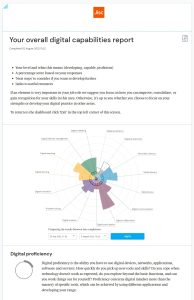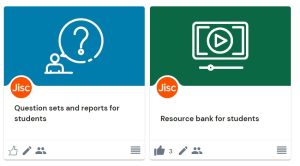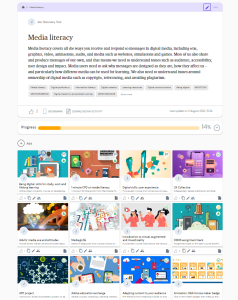
The discovery tool, a key part of our Building digital capability service, helps individuals to identify their digital strengths. It also aids individuals in identifying areas they might like to work on to improve their overall ability to take advantage of the wide range of opportunities available to them in a digital world.
The question sets in the discovery tool are targeted at different groups, including staff and students in general, teaching staff, individuals with responsibility for accessibility, library staff, and students just starting out in Further or Higher Education. Completing any of these question sets generates a personalised report. This report is ideal for staff to use in professional development reviews (appraisals) as well as for students to use in tutorials.

Patrick Turner from Leeds Trinity University told us about how he has implemented the discovery tool at the university. He has actively worked with academic staff and ingrained the tool in professional development programmes. (Captions embedded in YouTube video)
Completing a questionnaire should not be the end of a user’s journey with the discovery tool. We have chosen some key resources to help individuals reach the next level in their digital journey. Resources are highlighted in two key places – in the resource bank and in a user’s report. Users can keep returning to the tool at their leisure to consult these resources. When promoting the tool, it is well worth pointing out these resources to your users, as well as how they can access them. We would recommend that users bookmark sections of the resource bank they are interested in. And why not add links to your intranet pages too: you can link to individual playlists or resources.
At the end of each section of the personalised reports are selected resources that are a great first step to developing skills in particular areas of digital capability. These are resources we have identified as particularly useful for key areas of the capabilities framework.

To re-access their reports and the recommended resources, a user just needs to navigate to the homepage of discovery tool then click the thumbnail for question sets and reports. From there they can see all the question sets available to them, re-access their reports and see the recommended resources within.

The discovery tool also contains an expanded, curated resource bank, broken down into the elements of the overall digital capability framework and the more targeted capability frameworks (online teaching, effective teaching, accessibility, new students). To access these, from the discovery tool home page users simply need to click through to the resource bank and they can explore playlists of resources sorted into different areas of digital capability.

New resources are added regularly and out-of-date resources are replaced with more suitable ones that emerge. Currently there are over 800 resources in the resource bank. Although there is a very wide range, they are carefully curated based on criteria of relevance, quality and timeliness. We do not intend to overload users with too many resources. We also try to ensure a balance between the areas of concern raised by further education colleges, higher education organisations and skills providers, as well as resources that address the needs of those working at the different levels of the capability framework.
The descriptions that accompany resources make it clear who a resource is relevant for, especially what sector it is targeted towards (e.g. HE, FE, skills), and what level of capability the resource speaks to. Most resources would be of use to the vast majority of users. We have included a wide range of types of resource, including online courses (MOOCs and smaller learning modules), blogposts, guides, how-to videos, webinars, useful productivity and proficiency tools, community mailing lists, and Jisc services. Users should be able to find something to match their personal learning preferences quite easily.
A student from Plymouth University told us about how she has found the discovery tool invaluable in the first year of her PhD course. Her report identified some of the productivity skills she needed to work on and has shown her some of the areas that will be beneficial to work on to aid her in the job market in the future. (Captions embedded in YouTube video)
In order to make the resource bank even more useful to individual users, organisations are permitted to add a selection of their own resources. Up to 15 resources can be added into the discovery tool by organisational administrators. Resources you add will only be viewable by those in your organisation. Adding your own resources means users can more easily find resources relevant to their learning journey in your organisation.
There are lots of factors you might consider when deciding which resources to add, but we have found it is particularly worth adding links to internal training offerings and information about the specific support available in your organisation. To make the best use of the 15 resources, you may consider linking to pages that collate information about the range of support available in a range of digital capability areas. For example, you might link to an intranet or VLE page that outlines internal training opportunities, how-to guides or support documentation. This may be more useful than linking to individual external resources (e.g. external courses, websites or blogposts) on specific areas of digital capability. On the other hand, if there are particular areas of capability that concern your staff or students (e.g. how best to use platforms like LinkedIn or how they can legally reuse copyrighted materials) you may decide linking to best practice guides is more useful. It is up to you! Do take a look at our guidance for organisations if you have not already added resources to the discovery tool.
There are many different approaches colleges and universities have taken towards implementing and embedding the discovery tool into various contexts for staff and student use. Sioned Llywelyn from Aberystwyth University spoke to us about how she got users on board and her approach to identifying gaps in digital capabilities development. (Captions embedded in YouTube video)
This blogpost has discussed the resources that sit behind the question sets, and how they can be accessed by users. As well as thinking about how you might embed the question sets in your digital capabilities support offering for staff and students, it is also worth thinking in particular about how you can promote the resources to your users. This will help encourage return visits to the tool, but more importantly encourage individuals to identify training and support to help them further along their journey towards digital confidence. Please take a look at our support website’s resources and community section for further approaches to embedding the tool in your organisation.
Explore our discovery tool resource bank (subscribers only).
Updated August 2022.
